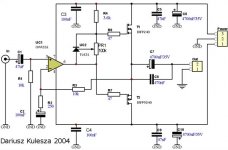Here you are the recent address of this forum.
http://www.audiostereo.pl/forum_wpisy.html?temat=5755&p=5#k
When you want to know another projects of this author press the links below.
http://www.q-audio.pl/
http://q-audio.dis.pl/gallery/
http://www.audiostereo.pl/forum_wpisy.html?temat=5755&p=5#k
When you want to know another projects of this author press the links below.
http://www.q-audio.pl/
http://q-audio.dis.pl/gallery/
maybe you guys read the question wrongly...but he wanted BJTs as outputs...not MOSfets...hmmm but it does seem interesting though...there were some posts by Circltron on Current damping afterburners on Power opamps...
since we're on this topic...I wanted to ask if there is any possibility of power outputs of over 200W...into 4 ohms that is...using this kinda configuration...
Specification of the amp mentioned by mik.
PSU: +/- 28V,
gain: +41V/V
load: 4 Ohm
quiscent current:120mA
THD+N: 0.008% (22Hz to 22kHz, P =1 to 10W)
THD+N: 0.014% (22Hz to 22kHz, P = 11 to 40 W)
THD+N: 0.6% (22Hz to 22kHz, P = 41 to 75W)
SR: +22/-18V/us
About a specification of other amps from mentioned gallery you should mail to dariuszkulesza@wp.pl
PSU: +/- 28V,
gain: +41V/V
load: 4 Ohm
quiscent current:120mA
THD+N: 0.008% (22Hz to 22kHz, P =1 to 10W)
THD+N: 0.014% (22Hz to 22kHz, P = 11 to 40 W)
THD+N: 0.6% (22Hz to 22kHz, P = 41 to 75W)
SR: +22/-18V/us
About a specification of other amps from mentioned gallery you should mail to dariuszkulesza@wp.pl
Thanks for the info. Unfortunately i don't speak Polish but have still managed to glean some info.
I have also found an Amp on the ESP site plus "Op-Amp Boosters" are also covered in an application note on the National Semiconductor site plus I found an old JLH reference in his articles in ETI 1986 (from memory).
As for power output, this is limited by the drive capability of the opamp (available output current and voltage swing) i would imagine.
The reason for looking into this aspect of amp design is that I'm not too happy with trying to use a "one chip" power amp as i don't think that the thermal properties of the chip/heat sink would be too good and BJT's should be better. Also using a "front end" of known characteristics allows one to then look at the ouput current gain topology more closely.
Regards
I have also found an Amp on the ESP site plus "Op-Amp Boosters" are also covered in an application note on the National Semiconductor site plus I found an old JLH reference in his articles in ETI 1986 (from memory).
As for power output, this is limited by the drive capability of the opamp (available output current and voltage swing) i would imagine.
The reason for looking into this aspect of amp design is that I'm not too happy with trying to use a "one chip" power amp as i don't think that the thermal properties of the chip/heat sink would be too good and BJT's should be better. Also using a "front end" of known characteristics allows one to then look at the ouput current gain topology more closely.
Regards
mandat said:Here you are the recent address of this forum.
http://www.audiostereo.pl/forum_wpisy.html?temat=5755&p=5#k
When you want to know another projects of this author press the links below.
http://www.q-audio.pl/
http://q-audio.dis.pl/gallery/
damn.. q-audio links are both dead....
I've found new realase of project.
unfortunately I don't speak Polish...
someone have info, PCB and docs about this very interesting project?
Attachments
http://www.diyaudio.com/forums/showthread.php?s=&threadid=66593&highlight=lm4702polsol said:
As for power output, this is limited by the drive capability of the opamp (available output current and voltage swing) i would imagine.
The reason for looking into this aspect of amp design is that I'm not too happy with trying to use a "one chip" power amp as i don't think that the thermal properties of the chip/heat sink would be too good and BJT's should be better.......
for info on an "opamp" with driver and output stage separated to avoid your heat concern.
Since it is designed as a power amp driver it includes a fair smattering of protection as well.
A "normal" opamp is limited to an output of about 14Vac. This in turn limits power to 50W into 4ohm or when bridged 100W into 8ohm, unless there is voltage amplification after the opamp. But that then brings one very close to a full discrete design.
QSC Audio uses a chip op amp to drive bipolar output transistors in some very high power amplifiers (> 2 KW!) for concert sound use. You can find some of the schematics at their website, http://www.qscaudio.com/ . Many of these designs use the NE5532.
- Status
- Not open for further replies.
- Home
- Amplifiers
- Chip Amps
- OPAMP with Transistor Output
